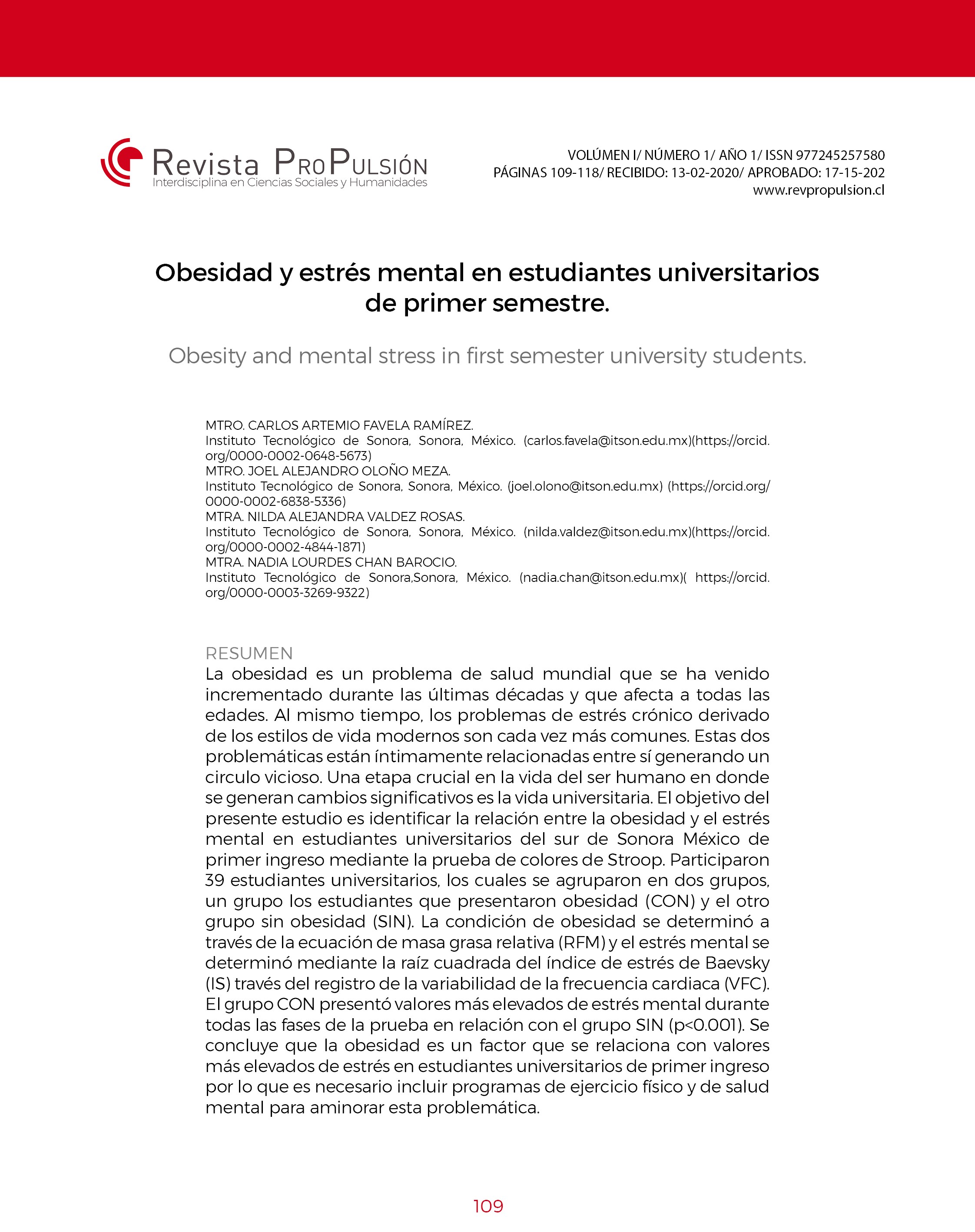Obesidad y estrés mental en estudiantes universitarios de primer semestre
DOI:
https://doi.org/10.53645/revprop.v1i1.79Palabras clave:
estrés mental, variabilidad de la frecuencia cardiaca, obesidad, salud, dietética, efectos fisiológicosResumen
La obesidad es un problema de salud mundial que se ha venido incrementado durante las últimas décadas y que afecta a todas las edades. Al mismo tiempo, los problemas de estrés crónico derivado de los estilos de vida modernos son cada vez más comunes. Estas dos problemáticas están íntimamente relacionadas entre sí generando un círculo vicioso. Una etapa crucial en la vida del ser humano en donde se generan cambios significativos es la vida universitaria. El objetivo del presente estudio es identificar la relación entre la obesidad y el estrés mental en estudiantes universitarios del sur de Sonora México de primer ingreso mediante la prueba de colores de Stroop. Participaron 39 estudiantes universitarios, los cuales se agruparon en dos grupos, un grupo los estudiantes que presentaron obesidad (CON) y el otro grupo sin obesidad (SIN). La condición de obesidad se determinó a través de la ecuación de masa grasa relativa (RFM) y el estrés mental se determinó mediante la raíz cuadrada del índice de estrés de Baevsky (IS) través del registro de la variabilidad de la frecuencia cardiaca (VFC). El grupo CON presentó valores más elevados de estrés mental durante todas las fases de la prueba en relación con el grupo SIN (p<0.001). Se concluye que la obesidad es un factor que se relaciona con valores más elevados de estrés en estudiantes universitarios de primer ingreso por lo que es necesario incluir programas de ejercicio físico y de salud mental para aminorar esta problemática.
Descargas
Citas
Bentham, J., Di Cesare, M., Bilano, V., Bixby, H., Zhou, B., Stevens, G. A., Riley, L. M., Taddei, C., Hajifathalian, K., Lu, Y., Savin, S., Cowan, M. J., Paciorek, C. J., Chirita-Emandi, A., Hayes, A. J., Katz, J., Kelishadi, R., Kengne, A. P., Khang, Y. H., ... Cisneros, J. Z. (2017). Worldwide trends in body-mass index, underweight, overweight, and obesity from 1975 to 2016: a pooled analysis of 2416 population-based measurement studies in 128·9 million children, adolescents, and adults. The Lancet, 390(10113), 2627–2642. https://doi.org/10.1016/ S0140-6736(17)32129-3
Bryant, C. X., Green, D. J., & American Council on Exercise. (2008). ACE lifestyle & weight management consultant manual : the ultimate resource for fitness professionals. 526.
Chu, D. T., Minh Nguyet, N. T., Dinh, T. C., Thai Lien, N. V., Nguyen, K. H., Nhu Ngoc, V. T., Tao, Y., Son, L. H., Le, D. H., Nga, V. B., Jurgoński, A., Tran, Q. H., Van Tu, P., & Pham, V. H. (2018). An update on physical health and economic consequences of overweight and obesity. Diabetes and Metabolic Syndrome: Clinical Research and Reviews, 12(6). https:// doi.org/10.1016/j.dsx.2018.05.004
Farah, B. Q., Andrade-Lima, A., Germano-Soares, A. H., Christofaro, D. G. D., de Barros, M. V. G., do Prado, W. L., & Ritti-Dias, R. M. (2018). Physical Activity and Heart Rate Variability in Adolescents with Abdominal Obesity. Pediatric Cardiology, 39(3), 466–472. https://doi. org/10.1007/s00246-017-1775-6
Gisselman, A. S., DʼAmico, M., & Smoliga, J. M. (2020). Optimizing Intersession Reliability of Heart Rate Variability-The Effects of Artifact Correction and Breathing Type. Journal of Strength and Conditioning Research, 34(11), 3199–3207. https://doi.org/10.1519/ JSC.0000000000002258
González Sandoval, C. E., Díaz Burke, Y., Mendizabal-Ruiz, A. P., Medina Díaz, E., & Morales, J. A. (2014). Prevalencia de obesidad y perfil lipídico alterado en jóvenes universitarios . In Nutrición Hospitalaria (Vol. 29, pp. 315–321). scieloes .
Grassi, G., Biffi, A., Seravalle, G., Trevano, F. Q., Dell’oro, R., Corrao, G., & Mancia, G. (2019). Sympathetic Neural Overdrive in the Obese and Overweight State: Meta- Analysis of Published Studies. Hypertension, 74(2), 349–358. https://doi.org/10.1161/ HYPERTENSIONAHA.119.12885
Guzmán-León, A. E., Velarde, A. G., Vidal-Salas, M., Urquijo-Ruiz, L. G., Caraveo-Gutiérrez, L. A., & Valencia, M. E. (2019). External validation of the relative fat mass (RFM) index in adults from north-west Mexico using different reference methods. PLOS ONE, 14(12), e0226767. https://doi.org/10.1371/JOURNAL.PONE.0226767
Hewagalamulage, S. D., Lee, T. K., Clarke, I. J., & Henry, B. A. (2016). Stress, cortisol, and obesity: a role for cortisol responsiveness in identifying individuals prone to obesity. Domestic Animal Endocrinology, 56, S112–S120. https://doi.org/10.1016/J.DOMANIEND.2016.03.004
Jarczok, M. N., Koenig, J., Wittling, A., Fischer, J. E., & Thayer, J. F. (2019). First Evaluation of an Index of Low Vagally-Mediated Heart Rate Variability as a Marker of Health Risks in Human Adults: Proof of Concept. Journal of Clinical Medicine, 8(11). https://doi.org/10.3390/ JCM8111940
Kim, H. G., Cheon, E. J., Bai, D. S., Lee, Y. H., & Koo, B. H. (2018). Stress and Heart Rate Variability: A Meta-Analysis and Review of the Literature. Psychiatry Investigation, 15(3), 235. https:// doi.org/10.30773/PI.2017.08.17
Larabee, C. M., Neely, O. C., & Domingos, A. I. (2020). Obesity: a neuroimmunometabolic perspective. Nature Reviews Endocrinology, 16(1), 30–43. https://doi.org/10.1038/s41574- 019-0283-6
López-Villalobos, J. A., Serrano-Pintado, I., Andrés-De Llano, J. M., Sánchez-Mateos, J. D., Alberola-López, S., & Sánchez-Azón, M. I. (2010). Usefulness of the Stroop test in attention deficit hyperactivity disorder. Revista de Neurologia, 50(6), 333–340. https://doi. org/10.33588/rn.5006.2009418
OMS. (2021). Obesidad y sobrepeso. https://www.who.int/es/news-room/fact-sheets/detail/ obesity-and-overweight
Pope, Z. C., Gabriel, K. P., Whitaker, K. M., Chen, L. Y., Schreiner, P. J., Jacobs, D. R., Sternfeld, B., Carr, J. J., Lloyd-Jones, D. M., & Pereira, M. A. (2020). Association Between Objective Activity Intensity & Heart Rate Variability: CVD Risk Factor Mediation (CARDIA). Medicine and Science in Sports and Exercise, 52(6), 1314. https://doi.org/10.1249/MSS.0000000000002259
Qi, Z., & Ding, S. (2016). Obesity-associated sympathetic overactivity in children and adolescents: The role of catecholamine resistance in lipid metabolism. Journal of Pediatric Endocrinology and Metabolism, 29(2), 113–125. https://doi.org/10.1515/JPEM-2015-0182/ MACHINEREADABLECITATION/RIS
Quendler, E., Trieb, K., & Nimmerichter, A. (2017). Validation of automated detection of physical and mental stress during work in a Hühnermobil 225. Annals of Agricultural and Environmental Medicine, 24(2), 329–331. https://doi.org/10.5604/12321966.1235183 Rastović, M., Srdić-Galić, B., Barak, O., Stokić, E., & Polovina, S. (2019). Aging, heart rate variability and metabolic impact of obesity. Acta Clinica Croatica, 58(3), 430–438. https://doi.org/10.20471/acc.2019.58.03.05
Romero-Corral, A., Somers, V. K., Sierra-Johnson, J., Thomas, R. J., Collazo-Clavell, M. L., Korinek, J., Allison, T. G., Batsis, J. A., Sert-Kuniyoshi, F. H., & Lopez-Jimenez, F. (2008). Accuracy of Body Mass Index to Diagnose Obesity In the US Adult Population. International Journal of Obesity (2005), 32(6), 959. https://doi.org/10.1038/IJO.2008.11
Saito, I., Hitsumoto, S., Maruyama, K., Nishida, W., Eguchi, E., Kato, T., Kawamura, R., Takata, Y., Onuma, H., Osawa, H., & Tanigawa, T. (2015). Heart Rate Variability, Insulin Resistance, and Insulin Sensitivity in Japanese Adults: The Toon Health Study. Journal of Epidemiology, 25(9), 583–591. https://doi.org/10.2188/JEA.JE20140254
Sánchez-Ojeda, M. A., & Luna-Bertos, E. De. (2015). Hábitos de vida saludable en la población universitaria . In Nutrición Hospitalaria (Vol. 31, pp. 1910–1919). scieloes .
Svensson, M. K., Lindmark, S., Wiklund, U., Rask, P., Karlsson, M., Myrin, J., Kullberg, J., Johansson, L., & Eriksson, J. W. (2016). Alterations in heart rate variability during everyday life are linked to insulin resistance. A role of dominating sympathetic over parasympathetic nerve activity? Cardiovascular Diabetology, 15(1), 1–9. https://doi.org/10.1186/S12933- 016-0411-8/TABLES/3
Tomiyama, A. J. (2014). Weight stigma is stressful. A review of evidence for the Cyclic Obesity/Weight-Based Stigma model. Appetite, 82, 8–15. https://doi.org/10.1016/J. APPET.2014.06.108
Tomiyama, A. J. (2019). Stress and Obesity. Https://Doi.Org/10.1146/Annurev- Psych-010418-102936, 70, 703–718. https://doi.org/10.1146/ANNUREV- PSYCH-010418-102936
van der Valk, E. S., Savas, M., & van Rossum, E. F. C. (2018). Stress and Obesity: Are There More Susceptible Individuals? Current Obesity Reports, 7(2), 193. https://doi.org/10.1007/ S13679-018-0306-Y
Young, H. A., & Benton, D. (2018). Heart-rate variability: a biomarker to study the influence of nutrition on physiological and psychological health? Behavioural Pharmacology, 29(2-), 140. https://doi.org/10.1097/FBP.0000000000000383

Publicado
Versiones
- 2020-06-11 (2)
- 2020-06-11 (1)
Cómo citar
Número
Sección
Categorías
Licencia
Derechos de autor 2020 Carlos Favela, Joel Oloño, Nlda Valdez, Nadia Chan

Esta obra está bajo una licencia internacional Creative Commons Atribución-NoComercial 4.0.
- Esta licencia permite a los reutilizadores distribuir, remezclar, adaptar y construir sobre el material en cualquier medio o formato solo con fines no comerciales, y solo mientras se dé atribución al creador.Incluye los siguientes elementos: POR – Se debe dar crédito al creador NC – Solo se permiten usos no comerciales de la obra.







